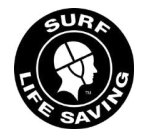(a) All events shall be judged and placings decided by Finish Judges.
(b) Once a competitor or team has been judged to have correctly crossed the finish line, they will be deemed to have completed that race. As such, the competitor/team will then not be permitted to re-enter the course to correct any previous race errors.
(c) Where available, electronic equipment (including video or other technology judging aids) may be utilised in the judging process. The finish position placings as decided by the Finish Judge(s) shall be regarded as final, and no protest or appeal shall be permitted.
(d) Where decals indicating the allocated finish positions are issued to competitors, it is the competitor’s responsibility to return the decal to the Recording Official to have their name and finish placing recorded.
(e) Video playback and electronic recording is for use only by appointed SLSA officials to determine event results. The Referee may allow competitors or team managers to view video playback or other electronic judging aids under controlled circumstances.
Note: Should video or other electronic judging aids be deemed necessary to properly determine the result of a race, the initial judging result shall not be declared as final and the Referee and Chief Judge shall determine the final finish result of the event. Such decision shall not be subject to protest.
(f) In events where competitors run to and across a finish line, the finish of the race is judged when the competitor crosses the line on their feet. The finish is judged on the chest of the competitor when crossing the finish line. Once a competitor has been judged to have correctly crossed the finish line, they will be deemed to have completed that race. As such, a competitor will then not be permitted to re-enter the course to correct any previous race errors.
Note: Falling across the line is not deemed to have finished the event.
(g) In events such as Skis and Boats (wet finishes), the finish placing is judged when any part of the competitor/team’s craft correctly crosses the finish line.
Note: Where video cameras are used to assist with the judging process the judging (finish) line may be modified to accommodate the optimum use of such technology e.g. rigid poles without flags may be used for Surf Boat or ski events judging. Finish flags may also then be placed on the shoreward side of the rigid judging line poles and as close as practical to the rigid judging line poles. Competitors and their craft are expected to proceed past the judging line and through the finish flags to complete a race.
(h) In events where competitors finish or finish a leg of a team event at a swim buoy:
- (i) The competitor on reaching the allotted buoy shall place their forearm over the top of the buoy and then signal their arrival by raising their other arm to a vertical position whilst remaining in contact with the buoy.
- (ii) The said signal, subject to all conditions being fulfilled, shall be the determining factor in judging the competitor’s arrival at the buoy.
- (iii) Should a competitor swim to an incorrect buoy and signal they shall be disqualified.
- (iv) In Belt Races and R&R events the competitor, if requested, shall indicate to the Course Judge-in-Boat that their line and belt are intact, by displaying the equipment to the Judge.
- (v) On returning to the beach placegetters should be informed of their finish position.
Note: The swimming buoy is described as the buoy only and does not include any attaching ropes or straps.
(i) It is further added that the Referee may authorise the wearing of electronic finish tags or other technology judging aids to assist the judging and/or recording of races finishes:
- (i) Competitors must place the technology judging aids as directed by the Referee or delegated official on their person or craft (e.g., around their wrist (for LiveHeats), on a specified ankle, or placed on a designated part of their craft/boat).
- (ii) Should the technology enable the judging of races, the result of such races shall then be determined by the order of the finish of the technology judging aids across the finish line.
- (iii) In the event of failure or unreliability of the electronic judging aid, all placings in a race shall be visually judged as per traditional methods.

